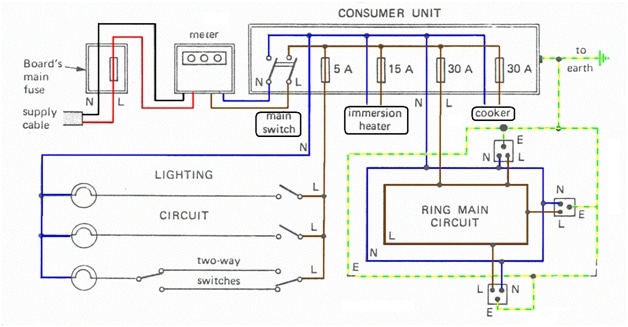K. is one of the newest members of the community and has been sending us articles for few weeks now. Today he chose to focus on domestic electrical wiring.
You can send us your writings too via email.
Introduction
Electrical power is transferred from generating stations to consumers at different voltage levels. Electrical power can be considered just like gas or water and same rule applies to its distribution i.e. proper pipeline and associated valves/switches.
Electrical wiring is a proper calculation oriented process and wiring of every installation/facility varies according to its requirements and expectations. We will discuss the performance needs and protection schemes that should be installed within a good electrical wiring system of a home.
Domestic electrical wiring: main scheme
A typical domestic wiring should be capable of fulfilling all performance and safety regulations and therefore must be planned and approved before its implementation.

Wiring scheme of a household
Following components are necessary for an efficient electrical wiring system:
- a. Live and neutral connections from energy meter to the main consumer unit. A split consumer unit is also installed for more redundancy and user friendly operations.
- b. Proper circuit breakers are part and parcel of a successful electrical supply system. Ring type circuits are installed for feeding the main sockets of consumer units.
- c. Lighting circuits are considered an important part of wiring system and they are radial in nature (most of the time). Miniature circuit breakers of proper rating (usually 6 amperes) are also installed for the protection purpose.
- d. Incomer to consumer unit grounding connections.
- e. Heavy duty electrical wiring backed by dedicated breakers (radial) for high power equipment like HVAC, cookers, heavy duty geysers etc.
- f. Two way switches as desired.
- g. Outdoor connections (outside the premises) are also used for lighting purposes. Rating of the breaker governing these circuits should be tightly close to the maximum load to avoid power theft (in case).
- h. Very high power equipment like storage heating equipment should be powered directly by the consumer unit.
Consumer unit / fuse box
A consumer unit comprises of an isolator, dedicated miniature circuit breakers (separate for every major circuit), grounding terminals and well defined circuit paths.
Grounding connections
Proper grounding connection is a vital part of every electrical installation. Basic purpose of earthing is to ensure that fault current flows through the system immediately after the fault has occurred resultantly tripping the main circuit. This prevents the floating voltage condition and thus fatal/non-fatal accidents.
A functional earthing system is a must have for every domestic/industrial wiring system. In case the power company does not provide it, it should be arranged locally for the greater good.
Electric shock prevention/minimization
Recent wiring regulations emphasize on RCBOs or RCDs (residual current devices) in an electrical wiring circuit.

Residual Current Device
These devices are crucial for electric shock prevention but relying on them for personnel safety is highly not recommended. Especially sockets and vulnerable switches must be protected by residual current devices. Separate RCBOs or RCDs are recommended for every ring or radial circuit.
Sockets
Recommended number of sockets are crucial for residents’ satisfaction and safety. Number and location of sockets in a wiring system should be precisely taken care of. Less and widely spread sockets encourage the use of circuit extensions which pose a safety risk.
Fuses/MCBs
Fuses and MCBs serve the same purpose i.e. disconnection of fault from the circuit. Fuses are recommended for lighting circuits as they are less sensitive to false alarms and bulb failure or other extremely transient faults do not cause trouble or unnecessary nuisance. Some MCBs are lesser sensitive and they can be used for lighting purpose.
Fuses and miniature circuit breakers are backbone of domestic electrical protection. Failure to design and implement an effective fuse/breaker sequence always results in catastrophic scenarios.
Voltage fluctuation protection
Voltage provided by a power company is prone to fluctuate no matter how well designed a system is. There are documented incidents where domestic electric wiring was exposed to high voltages. This is a very undesirable consequence and should be countered with the installation of voltage sensors.
Voltage fluctuation control system identifies voltage abnormalities and trips the circuit. Over voltage exposure can cause the weakening or failure of cables’ insulation. Voltages below the rated values can also damage the equipment and can render the protection devices useless. A well designed voltage controller is always recommended for domestic electric wiring.
Color coding
Color coding is an agreed upon standard and should be followed in every electrical wiring. A separate and distinguishable color is assigned to every conductors’ insulation and it aids in identification and fault clearance of a circuit.
IEC standards (for three phase system) use brown, black and grey as live wire identifiers.
Further Reading
Following literature is recommended for study and practical implementation of electrical wiring principles
a. “Electrical Wiring Residential” by Ray C. Mullin, Phil Simmons.
b. “An Introduction to Electrical Wiring” by John M. Doyle.
c. “Electric Wiring for Domestic Installers” by Brian Scaddan.
K.
Thanks K. for this back to basics article. What do you all think of it? Comment down below.

